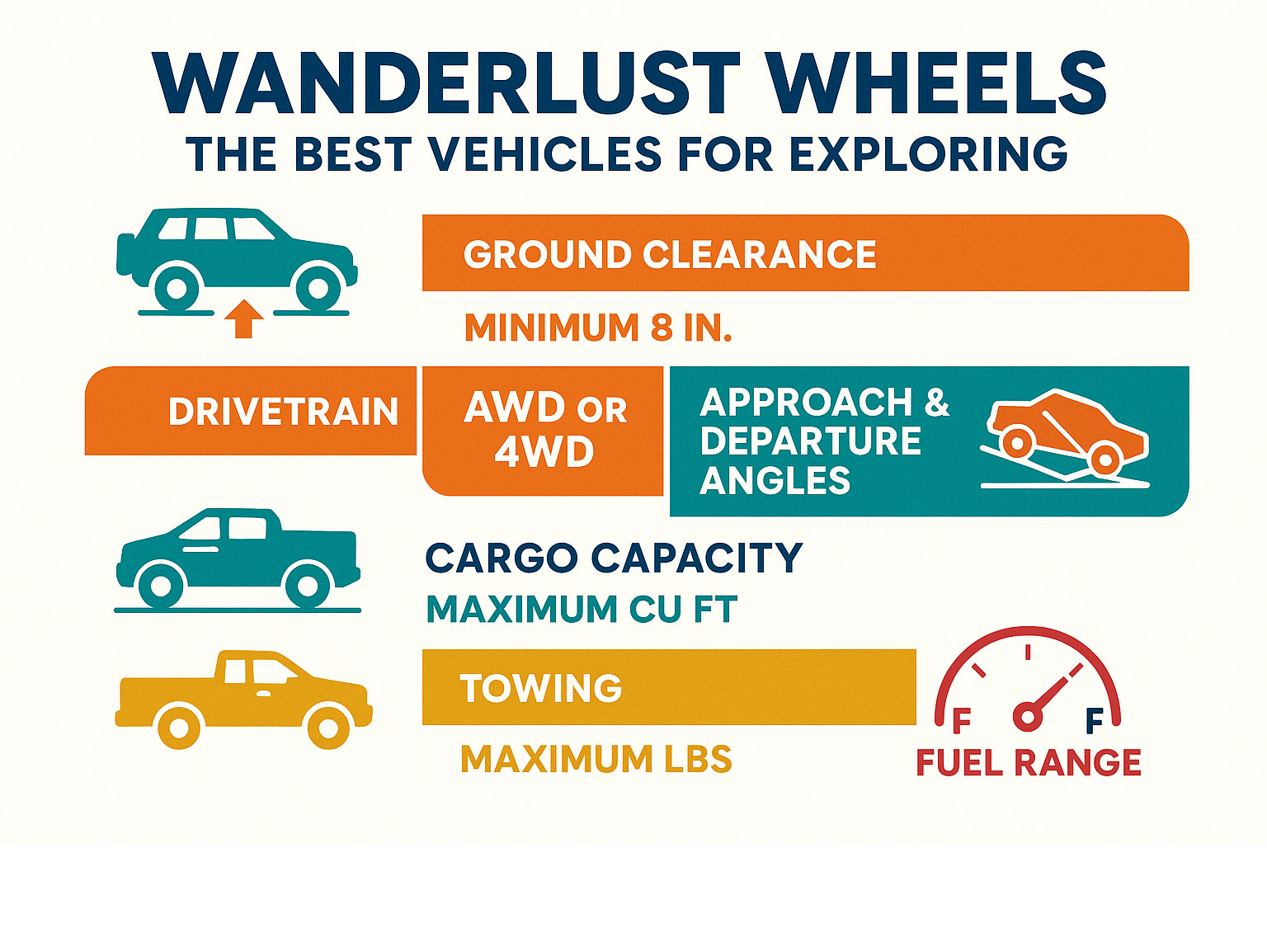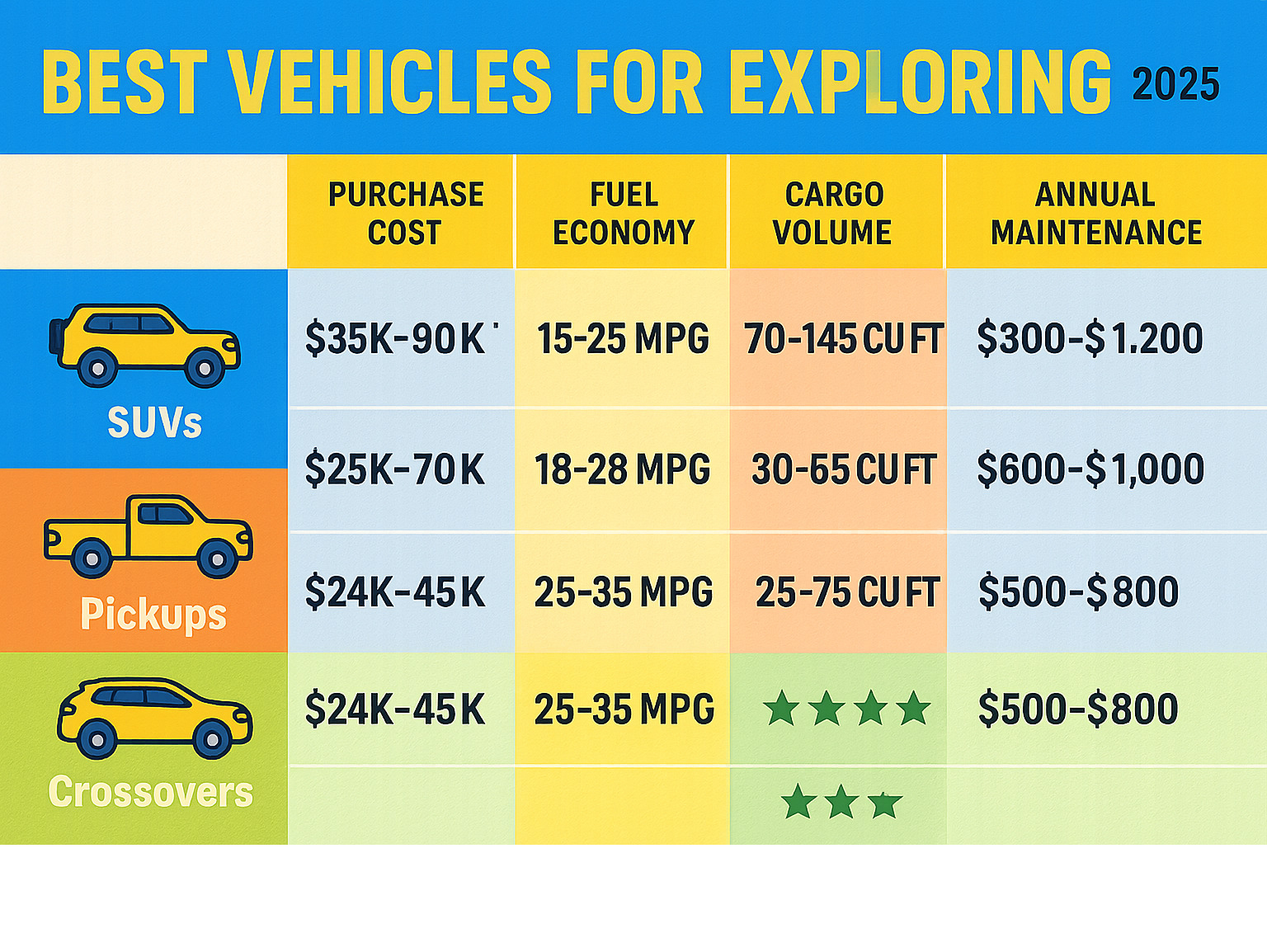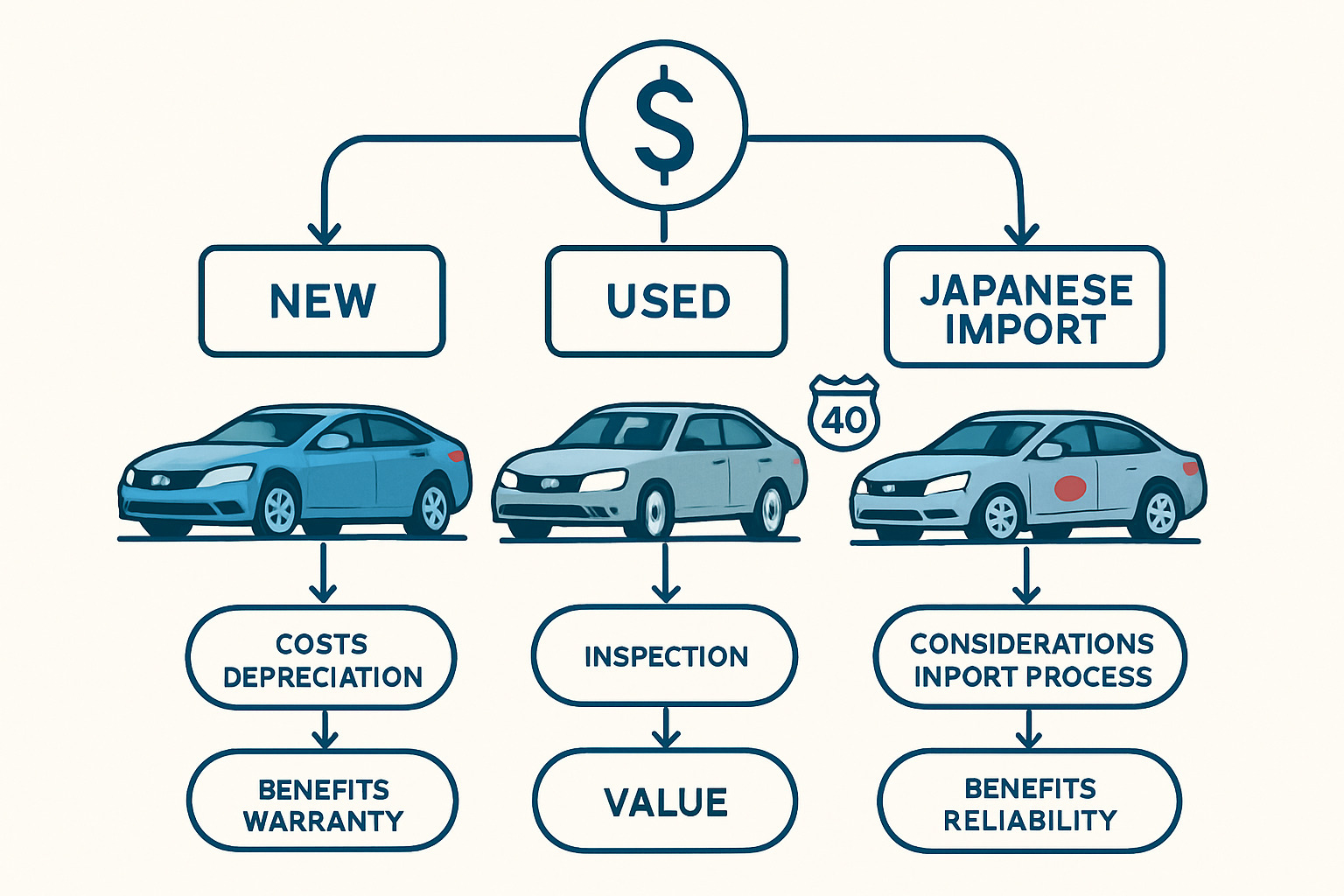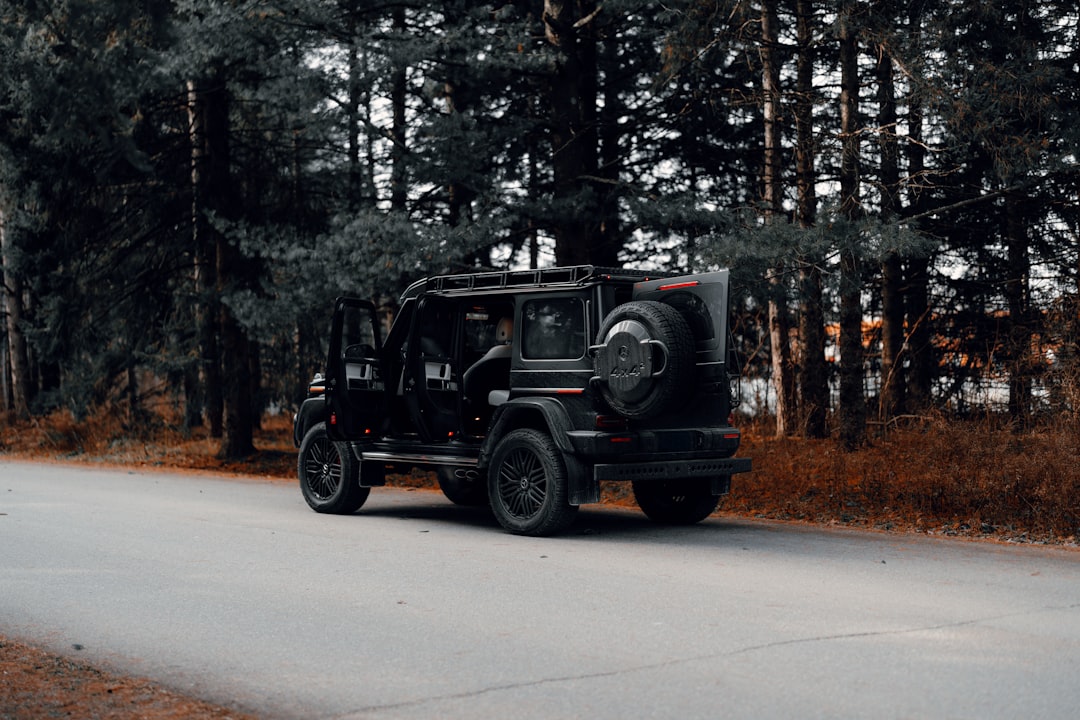Best Vehicle for Exploring: 10 Top Picks You’ll Love in 2025
Why Finding the Best Vehicle for Exploring Matters More Than Ever
The best vehicle for exploring combines rugged capability with modern comfort to take you anywhere your wanderlust leads. Here are the top categories that deliver:
SUVs for Serious Trips:
– Toyota 4Runner – Proven off-road reliability
– Jeep Grand Cherokee – Tech meets trail capability
– Rivian R1S – Electric power for eco-conscious explorers
Pickup Trucks as Mobile Basecamps:
– Ford Maverick FX4 – Compact size, big capability
– Toyota Tacoma – Mid-size versatility champion
– Nissan Frontier – Value-packed trip ready
Crossovers for Weekend Warriors:
– Subaru Outback – All-weather confidence
– Mazda CX-50 – Sporty handling meets utility
– Honda CR-V Hybrid – Fuel-efficient exploration
Whether you’re planning weekend camping trips or cross-country overland trips, the right vehicle transforms how you experience the outdoors. Ground clearance, drivetrain capability, and cargo flexibility separate true exploration vehicles from everyday commuters.
Modern exploring vehicles blend traditional 4WD systems with advanced traction control and terrain management modes. This tech makes challenging trails accessible while keeping experienced drivers safer on remote routes.

Quick look at best vehicle for exploring:
– best trip vehicles 2024
– best overland vehicles
– best vehicles for snow
What Makes a Vehicle Exploration-Ready?
So you’re wondering what transforms an ordinary vehicle into the best vehicle for exploring? After years of testing rigs across everything from muddy forest trails to rocky mountain passes, we’ve learned that certain features separate the weekend warriors from the vehicles that leave you stranded.
Ground clearance is your first line of defense against the unexpected. When you’re navigating fallen logs, jagged rocks, or deep ruts, you need at least 8 inches of clearance to keep your vital components safe. We’ve seen too many trips cut short by a cracked oil pan that could’ve been avoided with proper clearance.
Your drivetrain choice between AWD and 4WD determines where you can confidently venture. All-wheel drive handles wet pavement and light trails beautifully, automatically sending power where it’s needed. Four-wheel drive takes things up a notch, giving you the muscle for serious off-road trips when the trail gets gnarly.
Torque delivery becomes your best friend on steep climbs, especially when you’re loaded down with camping gear. Whether you’re dealing with a turbo-diesel’s low-end grunt or a hybrid’s instant electric boost, having the right power-to-weight ratio means the difference between conquering that hill and rolling backward.
Here’s where wheel articulation comes into play – it’s how well your wheels stay planted when the terrain gets uneven. Independent suspension keeps you comfortable on the highway, while solid axles give you maximum flex for serious rock crawling trips.
Approach and departure angles might sound technical, but they’re simply about not getting hung up on obstacles. Steep angles let you climb over rocks and logs that would catch lower-riding vehicles. Traction control works behind the scenes with your drivetrain, while hill-descent assist keeps you from picking up too much speed on sketchy descents.
Don’t overlook practical considerations like roof load limits for your kayaks or rooftop tent – most capable rigs handle 150-200 pounds up top. Water fording depth of 20-24 inches lets you cross streams confidently, though proper technique still matters.
Cargo flexibility with split-folding seats and multiple tie-down points makes organizing your gear so much easier. And modern safety tech like automatic emergency braking and satellite emergency services provides crucial backup when you’re exploring remote areas where cell service disappears.
For more detailed guidance on trip-ready capabilities, check our comprehensive Trip-Ready Vehicles guide.
Why Drivetrain Matters in the Best Vehicle for Exploring
The drivetrain is honestly the heart and soul of any exploration vehicle. We’ve put countless AWD and 4WD systems through their paces, and the differences become crystal clear when you’re facing challenging terrain.
AWD systems are like having a smart friend who’s always looking out for you. They automatically send power where it’s needed, handling wet roads, light snow, and gravel paths without you lifting a finger. Perfect for those camping trips where you encounter a mix of highway and forest service roads.
4WD systems bring the serious capability when things get tough. Part-time 4WD lets you save fuel in two-wheel drive mode until you need that extra traction. Full-time systems keep you ready for anything but drink a bit more fuel in the process.
Locking differentials are the ultimate problem-solver. When one wheel starts spinning uselessly, a locked diff ensures its partner keeps getting power. Front and rear lockers give you maximum capability for those “how did I even get here?” moments.
Low-range gearing multiplies your torque for technical work – think crawling over boulders or inching up impossibly steep grades. It’s all about precision and control rather than speed.
Ground Clearance & Suspension Basics
Ground clearance is your vehicle’s ability to clear obstacles without expensive scraping sounds. We strongly recommend a minimum of 8 inches for serious exploration, though 9-10 inches gives you that extra confidence margin when the trail throws surprises at you.
Skid plates are like armor for your vehicle’s vulnerable bits. Factory plates offer basic protection for the oil pan and transmission, while aftermarket options can shield everything from the fuel tank to the transfer case. Trust us, the investment pays for itself the first time you hear rocks bouncing off instead of crunching into vital components.
The choice between independent and solid axles comes down to your priorities. Independent suspension delivers that smooth highway ride and better traction on uneven surfaces. Solid axles sacrifice some comfort but give you maximum wheel articulation for serious rock crawling where every inch of flex matters.
The Best Vehicle for Exploring: Top Picks for 2024
After testing dozens of vehicles across rocky trails, sandy beaches, and snowy mountain passes, we’ve found the best vehicle for exploring options that truly deliver when the pavement ends. These aren’t just marketing claims – these vehicles have proven themselves in real-world conditions where reliability means everything.
The 2024 model year brings exciting updates across all categories. Price ranges span from budget-conscious choices around $30,000 to premium expedition machines exceeding $80,000. What matters most isn’t the price tag, but finding the right match for your exploration style and budget.
For deeper analysis of this year’s standout models, our Best Trip Vehicles 2024 guide covers additional testing details and comparison data.
SUVs Built for the Wild
The Toyota 4Runner remains our top pick for serious off-road exploration. This body-on-frame SUV combines a proven 4.0-liter V6 engine with a part-time 4WD system that’s been refined over decades. With 9.6 inches of ground clearance and approach angles of 33 degrees, it tackles obstacles that stop other SUVs cold.
What sets the 4Runner apart is its legendary reliability. We’ve seen these vehicles with 200,000+ miles still conquering trails without major issues. The simple, robust design means fewer things can break when you’re far from civilization.
The Jeep Grand Cherokee offers a more refined approach to off-road capability. Its Quadra-Drive II 4WD system includes electronic limited-slip differentials that automatically send power where it’s needed. The air suspension adjusts from highway comfort to serious off-road clearance of 10.9 inches at the touch of a button.
The Rivian R1S brings electric power to serious off-road exploration with impressive results. Four independent motors provide precise torque control to each wheel, creating traction capabilities that traditional drivetrains can’t match. Adjustable air suspension offers up to 14.9 inches of ground clearance for extreme terrain.
Pickups That Double as Basecamps
The Ford Maverick FX4 proves that compact pickups can handle serious exploration duties without the bulk of full-size trucks. Its available AWD system includes terrain management modes that optimize traction for different surfaces. At 8.6 inches of ground clearance, it steers most forest roads and camping areas with confidence.
The Toyota Tacoma sets the standard for mid-size pickup capability. The TRD Pro model includes Fox shocks, comprehensive skid plates, and crawl control for technical terrain. Multi-terrain select modes optimize the 4WD system for sand, mud, rock, and other challenging surfaces.
The Nissan Frontier delivers impressive value in the competitive mid-size pickup segment. Its standard 3.8-liter V6 engine provides ample power for loaded camping trips, while the available 4WD system includes an electronic locking rear differential for improved traction.
Crossovers & Compact Options
The Subaru Outback excels for mild to moderate exploration with its standard AWD system providing confidence in varied conditions. At 8.7 inches of ground clearance, it handles forest roads and camping areas that stop regular cars. The X-Mode system optimizes traction for snow, dirt, and gravel surfaces.
The Mazda CX-50 brings sporty handling to the trip crossover segment without sacrificing capability. The available AWD system includes off-road traction assist, while 8.6 inches of ground clearance handles most camping and trail situations.
The Honda CR-V Hybrid combines excellent fuel efficiency with adequate capability for light exploration. The AWD system provides confidence in varied weather and road conditions, while the spacious interior and cargo area accommodate camping gear for weekend trips.
Pros, Cons & Price Ranges at a Glance

SUVs typically range from $35,000-$90,000, offering the best balance of passenger comfort and cargo space. Fuel economy varies from 15-25 mpg depending on size and drivetrain. Maintenance costs average $800-1,200 annually for most models.
Pickup Trucks span $25,000-$70,000, providing maximum cargo flexibility and towing capability. Fuel economy ranges from 18-28 mpg, with compact models achieving better efficiency. Annual maintenance typically costs $600-1,000.
Crossovers offer the most affordable entry point at $24,000-$45,000, with excellent fuel economy of 25-35 mpg. Lower capability limits them to mild off-road use, but maintenance costs remain reasonable at $500-800 annually.
Off-road capability ratings consider ground clearance, drivetrain sophistication, and available traction aids. SUVs and pickups typically score highest, while crossovers excel in efficiency and comfort.
Preparation, Maintenance & Essential Mods
Getting your best vehicle for exploring trail-ready isn’t just about having the right specs – it’s about proper preparation and smart modifications that keep you moving when the pavement ends. After years of testing vehicles in remote locations, we’ve learned that most breakdowns happen because of simple maintenance issues that could have been prevented.
The foundation of reliable exploration starts with preventive maintenance checks that catch problems before they strand you miles from cell service. Your tire pressure deserves daily attention since it affects everything from traction to fuel economy. We’ve found that slightly lower pressures work wonders on sand and snow, but rocky terrain demands higher pressures to prevent punctures.
Brake wear becomes your silent enemy during mountain driving and heavy towing. Those steep descents and loaded trailers push your braking system harder than daily commuting ever could. Check your pads and rotors regularly, especially before long trips where brake fade could turn dangerous.
Fluid changes take on new importance when you’re pushing your vehicle through extreme conditions. Your engine oil, transmission fluid, and differential oil work overtime during off-road driving. Heat, dust, and constant load changes break down fluids faster than normal driving conditions.
Smart modifications improve capability without compromising reliability. All-terrain tires represent the single most effective upgrade for most explorers. They provide dramatically better traction than highway tires while maintaining reasonable road manners and fuel economy.
Roof tents transform any capable vehicle into a comfortable basecamp, though they do affect handling and fuel consumption due to added height and weight. The convenience of setting up camp anywhere often outweighs these compromises for serious explorers.
MAXTRAX recovery boards offer lightweight self-recovery capability that’s often more practical than heavy winch systems. They work equally well in sand, mud, or snow, and they’re compact enough to carry without major space sacrifices.
For more detailed camping vehicle guidance, check out our comprehensive Best Cars for Camping resource.
Choosing the Best Vehicle for Exploring Different Climates
Climate adaptation often matters more than raw capability when selecting your exploration vehicle. We’ve tested vehicles across desert heat, mountain snow, and everything in between – and learned that flexibility beats specialization for most explorers.
Snow chains remain legally required in many mountain areas during winter months. Before you need them in a blizzard, make sure your vehicle has adequate wheel well clearance and practice installation in your garage.
Engine block heaters become non-negotiable for diesel engines in extreme cold. These simple devices prevent the starting problems that strand unprepared travelers when temperatures drop below zero.
Sand ladders prove invaluable in desert environments where soft sand can trap even capable vehicles. Modern composite versions weigh less than traditional metal alternatives while providing effective traction when you need to dig out.
DIY Maintenance Schedule for Remote Trips
Extended remote exploration demands more frequent maintenance because dust, heat, and challenging terrain accelerate wear on every component. Your normal maintenance schedule simply won’t cut it when you’re pushing your vehicle through severe conditions for weeks at a time.
Oil change intervals should drop by 25-50% during severe-duty use. Dust infiltration and constant load changes break down oil faster than highway driving. Carry extra oil and filters for extended expeditions – running low on oil hundreds of miles from the nearest parts store isn’t an trip you want to experience.
Coolant system maintenance becomes critical when you’re dealing with extreme temperatures and steep grades. Inspect all hoses, clamps, and radiator condition before departing on extended trips. A burst hose in remote desert can quickly become a dangerous situation.
Buying Guide: New vs Used vs Japanese Imports

Choosing the best vehicle for exploring involves more than just picking your favorite model – smart budget planning can make or break your trip dreams. We’ve helped countless explorers steer these waters, and the right purchasing strategy depends entirely on your specific situation and goals.
New vehicles represent the safest bet if you want peace of mind. You’ll get full warranty coverage, cutting-edge safety technology, and that new-car reliability that’s hard to beat. The downside? Your wallet takes a serious hit upfront, and depreciation starts the moment you drive off the lot.
Used vehicles offer the sweet spot for many explorers – better bang for your buck without sacrificing too much capability. The key lies in careful inspection and research. Look for complete maintenance records, check for accident history, and pay special attention to signs of hard off-road use like rock chips, skid plate damage, or unusual wear patterns.
The depreciation curve works in your favor with used vehicles, especially after the steepest drop in the first few years. Toyota and Jeep models typically hold their value exceptionally well, which means higher used prices but also better resale when you’re ready to upgrade.
Japanese imports open up a fascinating world of vehicles never sold in our domestic market. These JDM (Japanese Domestic Market) vehicles often offer superior build quality and unique features, but they come with their own set of challenges and costs that many buyers don’t initially consider. According to the National Highway Traffic Safety Administration, imported vehicles must meet specific safety and emissions standards.
For deeper insights into expedition-ready options, check out our comprehensive Best Overland Vehicles guide.
Are Japanese Used Vehicles Worth It for Exploration?
Japanese used vehicles present an intriguing option for serious explorers, particularly older Toyota Land Cruisers, Nissan Patrols, and other models that never made it to our shores. The legendary durability of Japanese engineering makes these vehicles tempting, but several important factors deserve careful consideration.
Auction grades in Japan provide standardized condition ratings that help buyers understand what they’re getting. However, these visual assessments can’t reveal internal engine wear, transmission problems, or other mechanical issues that only show up after purchase.
Rust inspection demands extra attention, especially for vehicles from Japan’s coastal regions where salt air accelerates corrosion. What looks like surface rust might hide structural damage that compromises safety and requires expensive repairs.
Legal & Insurance Considerations
The 25-year rule allows importation of vehicles not originally sold in the US market, but newer vehicles face expensive EPA and DOT compliance requirements that can quickly exceed the vehicle’s value.
EPA compliance ensures imported vehicles meet our emissions standards, while DOT compliance covers safety requirements like lighting, bumpers, and crash standards. These modifications often cost several thousand dollars and require specialized knowledge to complete properly.
Frequently Asked Questions about Exploring Vehicles
When we talk to fellow explorers about choosing the best vehicle for exploring, three questions come up time and again. We’ve answered these countless times around campfires and at trailheads, so let’s tackle them properly.
How much ground clearance is enough?
Here’s the honest truth: 8 inches of ground clearance handles about 90% of what most explorers will ever encounter. This magic number gets you through forest roads, over fallen branches, across shallow creek crossings, and into those hidden camping spots that make the trip worthwhile.
But ground clearance isn’t just about the number on the spec sheet. We’ve seen vehicles with impressive clearance get hung up because of poor approach angles or low-hanging exhaust systems. The whole package matters more than any single measurement.
If you’re planning to tackle serious rock crawling or steer technical mountain passes, 9-10 inches becomes your new baseline. These extra inches make the difference between scraping your skid plates and gliding over obstacles with confidence.
AWD or 4WD—which is better for mixed terrain?
This question sparks more campfire debates than which camp stove burns hottest. Both systems have their place, and the right choice depends on how you actually explore.
AWD systems shine for the 80% of exploring that happens on mixed surfaces – wet highways, gravel forest roads, snowy mountain passes, and muddy camping areas. They work automatically, so you focus on the scenery instead of managing drivetrain settings.
4WD systems dominate when things get serious. Part-time 4WD lets you cruise efficiently in 2WD mode, then engage four-wheel drive when the trail gets challenging. Low-range gearing crawls you up steep grades or through technical sections at walking pace.
For most explorers mixing highway miles with forest roads and established camping areas, AWD provides the sweet spot of capability and convenience. Serious backcountry enthusiasts who regularly tackle challenging terrain benefit from 4WD’s additional capability.
What safety tech is non-negotiable for overland travel?
Remote exploration changes the safety equation completely. When the nearest help is hours away and cell service disappeared miles ago, certain technologies shift from nice-to-have to potentially life-saving.
Automatic emergency braking tops our list because wildlife encounters happen fast, especially during dawn and dusk driving. Fatigue affects reaction times on long travel days, and this system provides crucial backup when your reflexes slow down.
Satellite-based emergency services like OnStar or similar systems maintain communication even without cell coverage. These services can summon help and provide your exact GPS coordinates to rescue teams.
Electronic stability control prevents rollovers during emergency maneuvers around obstacles or wildlife. The system works faster than human reflexes and can save you from situations that would otherwise end badly.
Conclusion
Finding the best vehicle for exploring isn’t about picking the most expensive or most capable rig on the market. It’s about understanding your own trip style and matching it with a vehicle that delivers the right balance of capability, comfort, and dependability.
Your exploration freedom grows when you trust your vehicle completely. Whether you’re navigating rocky mountain passes or cruising forest service roads, confidence in your rig transforms how you experience the outdoors. The vehicles we’ve covered – from the legendary Toyota 4Runner to the innovative Rivian R1S – each provide that essential trust factor in their own way.
Trip longevity depends heavily on how well you maintain and prepare your chosen vehicle. Even the toughest SUV or most reliable pickup needs regular attention and smart modifications. The difference between a great trip and a memorable disaster often comes down to checking tire pressure, changing fluids on schedule, and carrying the right recovery gear.
Safety always comes first when you’re miles from cell towers and paved roads. Modern safety technology like automatic emergency braking and satellite emergency services provide crucial backup when things go wrong. But technology can’t replace good judgment and conservative decision-making in challenging conditions.
Most of us want one-vehicle versatility – a rig that handles Monday morning commutes and weekend camping trips with equal confidence. The crossovers and SUVs in our guide excel at this balancing act, delivering daily comfort without sacrificing trip capability.
At Car News 4 You, we live at the intersection of automotive innovation and outdoor culture. We understand that choosing an exploration vehicle involves both practical considerations and emotional connections. The right truck or SUV doesn’t just get you places – it enables experiences and creates memories that stick with you forever.
The best vehicle for exploring ultimately becomes the one that matches your specific needs, budget, and trip dreams. Whether that’s a fuel-efficient Subaru Outback for weekend camping or a fully-loaded Toyota Land Cruiser for serious expedition work, the perfect choice is the one that gets you out there safely and reliably.
Ready to dive deeper into selecting and preparing your ideal exploration partner? Our comprehensive Trip-Ready Vehicles guide provides the detailed insights you need to make the right choice. Your next great trip is waiting – you just need the right vehicle to get there.








